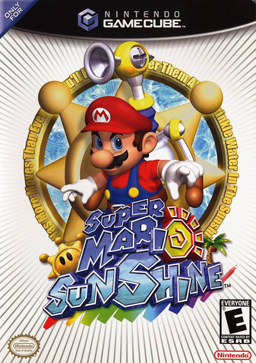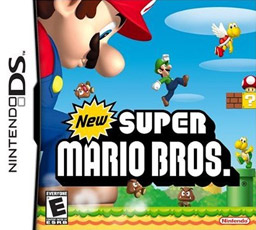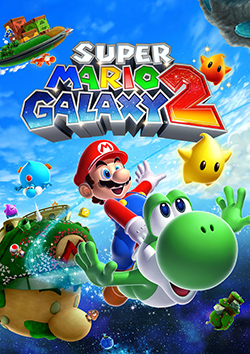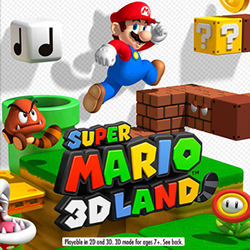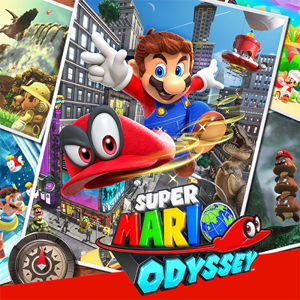Super Mario is a platform game series and media franchise created by Nintendo and featuring their mascot, Mario. Alternatively called the Super Mario Bros. series or simply the Mario series, it is the central series of the greater Mario franchise. At least one Super Mario game has been released for every major Nintendo video game console. There have also been a number of Super Mario video games released on non-Nintendo gaming platforms. How many Super Mario games there are has been debated. There are currently twenty-one similar games and one cross-series game that may or may not be included as part of the series.
Release timeline| 1985 | Super Mario Bros. |
|---|---|
| 1986 | Super Mario Bros.: The Lost Levels |
| 1987 | |
| 1988 | Super Mario Bros. 2 |
| Super Mario Bros. 3 | |
| 1989 | Super Mario Land |
| 1990 | Super Mario World |
| 1991 | |
| 1992 | Super Mario Land 2: 6 Golden Coins |
| 1993 | |
| 1994 | |
| 1995 | Super Mario World 2: Yoshi's Island |
| 1996 | Super Mario 64 |
| 1997 | |
| 1998 | |
| 1999 | |
| 2000 | |
| 2001 | |
| 2002 | Super Mario Sunshine |
| 2003 | |
| 2004 | |
| 2005 | |
| 2006 | New Super Mario Bros. |
| 2007 | Super Mario Galaxy |
| 2008 | |
| 2009 | New Super Mario Bros. Wii |
| 2010 | Super Mario Galaxy 2 |
| 2011 | Super Mario 3D Land |
| 2012 | New Super Mario Bros. 2 |
| New Super Mario Bros. U | |
| 2013 | Super Mario 3D World |
| 2014 | |
| 2015 | Super Mario Maker |
| 2016 | Super Mario Run |
| 2017 | Super Mario Odyssey |
| 2018 | |
| 2019 | Super Mario Maker 2 |
Super Mario Bros.
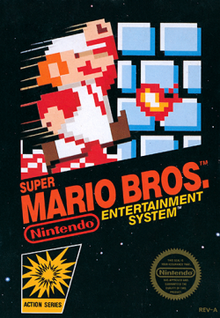
|
North American cover art
|
||
| Developer(s) | Nintendo EAD | |
|---|---|---|
| Publisher(s) | Nintendo | |
| Director(s) | Shigeru Miyamoto | |
| Producer(s) | Shigeru Miyamoto | |
| Designer(s) |
|
|
| Programmer(s) |
|
|
| Artist(s) |
|
|
| Composer(s) | Koji Kondo | |
| Series | Super Mario | |
| Platform(s) | ||
| Release | ||
| Genre(s) | Platform | |
| Mode(s) |
Single-player, multiplayer
|
|
Super Mario Bros. was released for the Nintendo Entertainment System (NES) and is the first side-scrolling 2D platform game to feature Mario. It established many core Mario gameplay concepts. The brothers Mario and Luigi live in the Mushroom Kingdom, where they must rescue Princess Toadstool (later called Princess Peach from Bowser/King Koopa. The game consists of eight worlds of four levels each, totaling 32 levels altogether. Though the worlds differ in themes, the fourth level is always a fortress or castle that ends with a fight against Bowser (or one of his minions disguised as him). This is one of the best-selling video games of all time.
| Super Mario Bros.: The Lost Levels | |
|---|---|

Japanese cover art
|
|
| Developer(s) | Nintendo R&D4 |
| Publisher(s) | Nintendo |
| Director(s) |
Takashi Tezuka Shigeru Miyamoto |
| Producer(s) | Shigeru Miyamoto |
| Designer(s) | Shigeru Miyamoto[1] |
| Programmer(s) | Toshihiko Nakago Kazuaki Morita |
| Composer(s) | Koji Kondo |
| Series | Super Mario |
| Platform(s) | Family Computer Disk System |
| Release |
|
| Genre(s) | Platform |
| Mode(s) | Single-player |
| Super Mario Bros. 2 | |
|---|---|
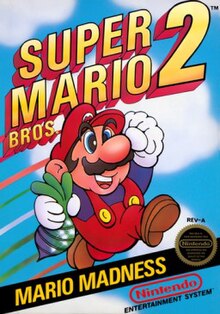
North American box art, showing Mario
|
|
| Developer(s) |
Nintendo R&D4 (NES, SNES) Nintendo R&D2 (GBA) |
| Publisher(s) | Nintendo |
| Director(s) | Kensuke Tanabe |
| Producer(s) | Shigeru Miyamoto |
| Designer(s) | Kensuke Tanabe Yoichi Yamada Hideki Konno |
| Programmer(s) | Toshihiko Nakago Yasunori Taketani Toshio Iwawaki |
| Artist(s) |
Tadashi Sugiyama Yōichi Kotabe |
| Composer(s) | Koji Kondo |
| Series | Super Mario |
| Platform(s) | NES, Arcade (PlayChoice-10), Super NES (SMAS), Game Boy Advance (Super Mario Advance) |
| Release | |
| Genre(s) | Platformer |
| Mode(s) | Single-player |
| Super Mario Bros. 3 | |
|---|---|

|
|
| Developer(s) | Nintendo EAD |
| Publisher(s) | Nintendo |
| Director(s) | |
| Producer(s) | Shigeru Miyamoto |
| Designer(s) |
|
| Programmer(s) | Toshihiko Nakago |
| Artist(s) |
|
| Composer(s) | Koji Kondo |
| Series | Super Mario |
| Platform(s) | Arcade (PlayChoice-10), Nintendo Entertainment System, Game Boy Advance |
| Release | |
| Genre(s) | Platforming |
| Mode(s) | Single-player, multiplayer |
| Super Mario Land | |
|---|---|

North American box art
|
|
| Developer(s) | Nintendo R&D1 |
| Publisher(s) | Nintendo |
| Director(s) | Satoru Okada |
| Producer(s) | Gunpei Yokoi |
| Designer(s) | Hirofumi Matsuoka |
| Programmer(s) | Takahiro Harada Masao Yamamoto |
| Artist(s) | Hirofumi Matsuoka Masahiko Mashimo |
| Composer(s) | Hirokazu Tanaka |
| Series | Super Mario |
| Platform(s) | Game Boy, Nintendo 3DS |
| Release | |
| Genre(s) | Platformer |
| Mode(s) | Single-player |
Super Mario Land is a 1989 side-scrolling platform video game developed and published by Nintendo as a launch title for their Game Boy handheld game console. It is the first Mario platform game ever to be released for a handheld console. In gameplay similar to that of the 1985 Super Mario Bros., but resized for the smaller device's screen, the player advances Mario to the end of 12 levels by moving to the right and jumping across platforms to avoid enemies and pitfalls. Unlike other Mario games, Super Mario Land is set in Sarasaland, a new environment depicted in line art, and Mario pursues Princess Daisy (who makes her debut in this game). The game also includes two Gradius-style shooter levels.
| Super Mario World | |||
|---|---|---|---|

North American box art
|
|||
| Developer(s) | Nintendo EAD | ||
| Publisher(s) | Nintendo | ||
| Director(s) | Takashi Tezuka | ||
| Producer(s) | Shigeru Miyamoto | ||
| Designer(s) | |||
| Programmer(s) | Toshihiko Nakago | ||
| Artist(s) | Shigefumi Hino | ||
| Composer(s) | Koji Kondo | ||
| Series | Super Mario | ||
| Platform(s) | Kiosk, Super NES, Game Boy Advance | ||
| Release | SNES Game Boy Advance | ||
| Genre(s) | Platform | ||
| Mode(s) | Single-player, multiplayer | ||
| Super Mario Land 2: 6 Golden Coins |
|
North American box art |
| Developer(s) | Nintendo R&D1 |
|---|---|
| Publisher(s) | Nintendo |
| Director(s) |
Hiroji Kiyotake Takehiko Hosokawa |
| Producer(s) | Gunpei Yokoi |
| Programmer(s) | Takahiro Harada Yuzuru Ogawa |
| Artist(s) | Hiroji Kiyotake Takehiko Hosokawa Makoto Kano |
| Composer(s) | Kazumi Totaka |
| Series | Super Mario |
| Platform(s) | Game Boy, Nintendo 3DS |
| Release |
Game Boy 3DS Virtual Console[1]
|
| Genre(s) | Platform |
| Mode(s) | Single-player |
| Super Mario World 2: Yoshi's Island |
|
North American cover art |
| Developer(s) | Nintendo EAD |
|---|---|
| Publisher(s) | Nintendo |
| Director(s) |
|
| Producer(s) | Shigeru Miyamoto |
| Artist(s) | |
| Composer(s) | Koji Kondo |
| Series | |
| Platform(s) | Super NES, Game Boy Advance |
| Release |
Super NES
|
| Genre(s) | Platform |
| Mode(s) | Single-player |
| Super Mario 64 |
|
North American cover art |
| Developer(s) | Nintendo EAD |
|---|---|
| Publisher(s) | Nintendo |
| Director(s) | Shigeru Miyamoto |
| Producer(s) | Shigeru Miyamoto |
| Composer(s) | Koji Kondo |
| Series | Super Mario |
| Platform(s) | Nintendo 64 |
| Release | |
| Genre(s) | Platform |
| Mode(s) | Single-player |
Super Mario Sunshine
|
| Developer(s) | Nintendo EAD |
|---|---|
| Publisher(s) | Nintendo |
| Director(s) |
|
| Producer(s) | |
| Designer(s) |
|
| Programmer(s) |
|
| Writer(s) | Makoto Wada |
| Composer(s) |
|
| Series | Super Mario |
| Platform(s) | GameCube |
| Release | |
| Genre(s) | Platformer |
| Mode(s) | Single-player |
New Super Mario Bros.
|
| Developer(s) | Nintendo EAD Group No. 4 |
|---|---|
| Publisher(s) | Nintendo |
| Director(s) | Shigeyuki Asuke |
| Producer(s) | Hiroyuki Kimura |
| Designer(s) | Masanao Arimoto |
| Programmer(s) |
|
| Composer(s) |
|
| Series | Super Mario |
| Platform(s) | Nintendo DS |
| Release | |
| Genre(s) | Platform |
| Mode(s) | Single-player, multiplayer |
| Super Mario Galaxy |
|
North American cover art |
| Developer(s) | Nintendo EAD Tokyo |
|---|---|
| Publisher(s) | Nintendo |
| Director(s) | Yoshiaki Koizumi |
| Producer(s) |
|
| Designer(s) |
|
| Programmer(s) |
|
| Artist(s) | Kenta Motokura |
| Writer(s) | Takayuki Ikkaku |
| Composer(s) | |
| Series | Super Mario |
| Platform(s) |
Wii Shield Tablet Nintendo Switch |
| Release |
Wii
Android
|
| Genre(s) | Platform, action-adventure |
| Mode(s) | Single-player, multiplayer |
New Super Mario Bros. Wii
|
| Developer(s) | Nintendo EAD |
|---|---|
| Publisher(s) | Nintendo |
| Director(s) | Shigeyuki Asuke |
| Producer(s) | |
| Composer(s) |
|
| Series | Super Mario |
| Platform(s) | Wii, Nvidia Shield TV |
| Release |
Wii
Nvidia Shield TV
|
| Genre(s) | Platform |
| Mode(s) | Single-player, multiplayer |
Super Mario Galaxy 2[
|
| Developer(s) | Nintendo EAD Tokyo |
|---|---|
| Publisher(s) | Nintendo |
| Director(s) | Koichi Hayashida |
| Producer(s) | |
| Designer(s) | Kenta Motokura |
| Programmer(s) | Takeshi Hayakawa |
| Artist(s) | Daisuke Watanabe |
| Composer(s) |
|
| Series | Super Mario |
| Platform(s) | Wii |
| Release | |
| Genre(s) | Platforming |
| Mode(s) | Single-player, multiplayer |
Super Mario 3D Land
|
| Developer(s) | Nintendo EAD Tokyo |
|---|---|
| Publisher(s) | Nintendo |
| Director(s) | Koichi Hayashida |
| Producer(s) | Yoshiaki Koizumi |
| Designer(s) | Kenta Motokura |
| Programmer(s) | Hideyuki Sugawara |
| Composer(s) |
|
| Series | Super Mario |
| Platform(s) | Nintendo 3DS |
| Release | |
| Genre(s) | Platform |
| Mode(s) | Single-player |
New Super Mario Bros. 2
|
| Developer(s) | Nintendo EAD Group No. 4 |
|---|---|
| Publisher(s) | Nintendo |
| Director(s) | Yusuke Amano |
| Producer(s) | |
| Programmer(s) | Kenji Higashiyama |
| Artist(s) | Masaaki Ishikawa |
| Composer(s) | Kenta Nagata |
| Series | Super Mario |
| Platform(s) | Nintendo 3DS |
| Release | |
| Genre(s) | Platforming |
| Mode(s) | Single-player, multiplayer |
New Super Mario Bros. U
|
| Developer(s) | Nintendo EAD |
|---|---|
| Publisher(s) |
Nintendo (Worldwide) Tencent Games (China, Deluxe only) |
| Director(s) | Masataka Takemoto |
| Producer(s) | |
| Designer(s) |
|
| Artist(s) | Masanobu Sato |
| Composer(s) |
|
| Series | Super Mario |
| Platform(s) |
Wii U Nintendo Switch |
| Release |
Wii U
Nintendo Switch
|
| Genre(s) | Platform |
| Mode(s) | Single-player, multiplayer |
Super Mario 3D World
|
| Developer(s) | Nintendo EAD Tokyo[a] |
|---|---|
| Publisher(s) | Nintendo |
| Director(s) | |
| Producer(s) | Yoshiaki Koizumi |
| Designer(s) |
|
| Programmer(s) |
|
| Artist(s) |
|
| Composer(s) |
|
| Series | Super Mario |
| Platform(s) |
Wii U Nintendo Switch |
| Release |
Wii U
Nintendo Switch
|
| Genre(s) | Platformer |
| Mode(s) |
Super Mario Maker
|
| Developer(s) | Nintendo EAD |
|---|---|
| Publisher(s) | Nintendo |
| Director(s) | Yosuke Oshino |
| Producer(s) | |
| Designer(s) |
|
| Artist(s) |
|
| Composer(s) |
|
| Series | Super Mario |
| Platform(s) | Wii U, Nintendo 3DS |
| Release | Wii U Nintendo 3DS |
| Genre(s) | Level editor, platform |
| Mode(s) | Single-player |
Super Mario Run
|
| Developer(s) | Nintendo EPD[a] |
|---|---|
| Publisher(s) | Nintendo |
| Producer(s) | Shigeru Miyamoto |
| Designer(s) | Takashi Tezuka |
| Series | Super Mario |
| Engine | Unity |
| Platform(s) | |
| Release |
|
| Genre(s) | Auto-running, platform |
| Mode(s) | Single-player |
Super Mario Odyssey
|
| Developer(s) | Nintendo EPD[a] |
|---|---|
| Publisher(s) | Nintendo |
| Director(s) | Kenta Motokura |
| Producer(s) |
|
| Designer(s) |
|
| Programmer(s) |
|
| Artist(s) |
|
| Writer(s) | Hiroaki Hishinuma |
| Composer(s) |
|
| Series | Super Mario |
| Platform(s) | Nintendo Switch |
| Release | October 27, 2017 |
| Genre(s) | Platform, action-adventure |
| Mode(s) | Single-player, multiplayer |
Super Mario Maker 2
|
| Developer(s) | Nintendo EPD |
|---|---|
| Publisher(s) | Nintendo |
| Director(s) | Yosuke Oshino |
| Producer(s) | |
| Designer(s) | |
| Programmer(s) | Fumiya Nakano |
| Artist(s) | Ryota Akutsu |
| Composer(s) |
|
| Series | Super Mario |
| Platform(s) | Nintendo Switch |
| Release | June 28, 2019 |
| Genre(s) | Level editor, platform |
| Mode(s) | Single-player, multiplayer |





